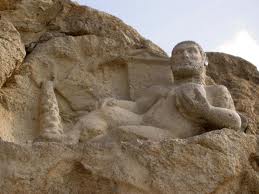Kermanshah is a city that borders both Iran and Iraq. This area is mostly mountainous and has a colder climate than most other cities in Iran. This is a very diverse city since it lies near the borders of both Iraq and Iran. Aside from Iranians, many people live here including Muslims, Assyrians, Jews, Yarsan and Armenians. Most of the residents here are Shia Muslims though.
Since Kermanshah is very diverse, the sites here vary from Mesopotamian, Greek, Roman, Zoroastrian and Islamic origins. Here are a few examples of these:
The Behistun is the ultimate symbol of Kermanshah’s diversity. The Behistun, UNESCO World Heritage Site, is a large limestone wall that has multi-lingual inscriptions in it. These inscriptions are Babylonian, Elamite and Old Persian. It is 15 meters high and 25 meter wide. It also has a bas relief image with Darius the Great, Persian Emperor. Another example a Persian monument here is the Taq-e Bostan. The Taq-e Bostan is a large grotto of an equestrian figure of King Khosrau II in his stallion Shadbiz.

A Muslim monument found in Kermanshah is the Mo’acenalmolk Mosque. This mosque is beautifully crafted and features unique Persian touches. In its wall, you will see the Shahnameh, the National Iranian epic, depicted in art. It also contains Islamic images. The Khaja Barookh House is a Jewish monument here. It is a house in the Jewish neighborhood of Kermanshah, built by Barookh, a Jewish merchant.

Kermanshah is a culturally-diverse Iranian destination that’s definitely worth visiting.

Since Kermanshah is very diverse, the sites here vary from Mesopotamian, Greek, Roman, Zoroastrian and Islamic origins. Here are a few examples of these:
The Behistun is the ultimate symbol of Kermanshah’s diversity. The Behistun, UNESCO World Heritage Site, is a large limestone wall that has multi-lingual inscriptions in it. These inscriptions are Babylonian, Elamite and Old Persian. It is 15 meters high and 25 meter wide. It also has a bas relief image with Darius the Great, Persian Emperor. Another example a Persian monument here is the Taq-e Bostan. The Taq-e Bostan is a large grotto of an equestrian figure of King Khosrau II in his stallion Shadbiz.
A Muslim monument found in Kermanshah is the Mo’acenalmolk Mosque. This mosque is beautifully crafted and features unique Persian touches. In its wall, you will see the Shahnameh, the National Iranian epic, depicted in art. It also contains Islamic images. The Khaja Barookh House is a Jewish monument here. It is a house in the Jewish neighborhood of Kermanshah, built by Barookh, a Jewish merchant.
Kermanshah is a culturally-diverse Iranian destination that’s definitely worth visiting.
famous-places.com
